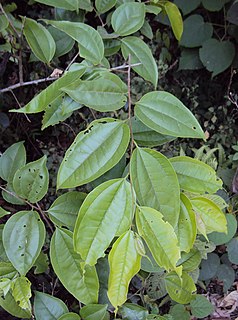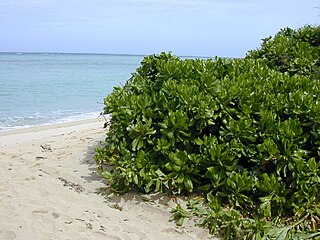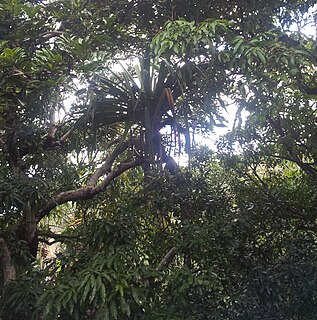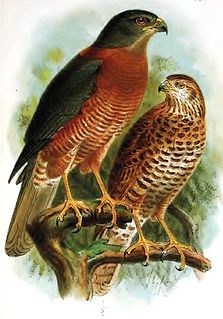
Pandanus is a genus of monocots with some 750 accepted species. They are palm-like, dioecious trees and shrubs native to the Old World tropics and subtropics. The greatest number of species are found in Madagascar and Malesia. Common names include pandan, screw palm, and screw pine. They are classified in the order Pandanales, family Pandanaceae.

Pandanus tectorius is a species of Pandanus (screwpine) that is native to Malesia, eastern Australia, and the Pacific Islands. It grows in the coastal lowlands typically near the edge of the ocean. Common names in English include thatch screwpine, Tahitian screwpine, hala tree, pandanus, and pu hala in Hawaiian. The fruit is sometimes known as hala fruit.

Pandanus spiralis is native to northern Australia. It is commonly called common screwpine, iidool, pandanus palm, screw pine, screw palm or spring pandanus. It is neither a true palm, nor a pine.

The flora of Australia comprises a vast assemblage of plant species estimated to over 20,000 vascular and 14,000 non-vascular plants, 250,000 species of fungi and over 3,000 lichens. The flora has strong affinities with the flora of Gondwana, and below the family level has a highly endemic angiosperm flora whose diversity was shaped by the effects of continental drift and climate change since the Cretaceous. Prominent features of the Australian flora are adaptations to aridity and fire which include scleromorphy and serotiny. These adaptations are common in species from the large and well-known families Proteaceae (Banksia), Myrtaceae, and Fabaceae.
Zehneria alba is a species of flowering plant in the cucumber and gourd family, Cucurbitaceae. It is endemic to Christmas Island, an Australian territory in the northeastern Indian Ocean. The specific epithet is from the Latin albus (white), referring to the colour of the flowers.

Pandanus christmatensis is a dioecious tropical plant in the screwpine genus. It is endemic to Christmas Island, an Australian territory in the north-eastern Indian Ocean. The specific epithet, "christmatensis", comes from its native locality.
Asystasia alba is a species of tropical herb in the family Acanthaceae. It is endemic to Christmas Island, an Australian territory in the north-eastern Indian Ocean. Its specific epithet comes from the Latin alba (white), referring to the colour of its flowers.
Grewia insularis is a species of flowering plant in the Malvaceae, or mallow family, that is endemic to Christmas Island, an Australian territory in the north-eastern Indian Ocean. Its specific epithet is the Latin for insular, referring to its island location.
Dendrobium nativitatis, commonly known as the Christmas Island crimp orchid, is a species of epiphytic orchid that is endemic to Christmas Island, an Australian territory in the north-eastern Indian Ocean. It has long, straggly stems, flattened pseudobulbs, a single leathery leaf and a single pale yellow flower.

Celtis timorensis, commonly known as stinkwood or stinking wood, is a species of flowering plant in the family Cannabaceae that grows in tropical Asia. The specific epithet comes from the name of the island of Timor, the locality of the type collection.

Scaevola taccada, also known as beach cabbage, sea lettuce, beach naupaka, naupaka kahakai (Hawaiian), magoo (Divehi), merambong (Malay), bapaceda or papatjeda, ngahu (Tongan) is a flowering plant in the family Goodeniaceae found in coastal locations in the tropical areas of the Indo-Pacific. It is a common beach shrub throughout the Arabian Sea, the tropical Indian Ocean and the tropical islands of the Pacific Ocean.

Pandanus forsteri , commonly known as forky-tree or forkedy-tree, is a flowering plant in the screwpine family. The specific epithet honours either Johann Forster or Georg Forster, father and son German botanists, who accompanied James Cook as naturalists on his second voyage (1772–1775).

Pandanus odorifer is an aromatic monocot species of plant in the family Pandanaceae, native to Polynesia, Australia, South Asia, and the Philippines, and is also found wild in southern India and Burma. It is commonly known as fragrant screw-pine.

The vascular plant flora of the Cocos (Keeling) Islands consists of approximately 61 species native to the 22 vegetated islands and about 69 introduced species, most of which are confined to the two larger inhabited islands, Home Island and West Island. There are no plant species endemic to the islands; however, one variety of Pandanus tectorius is only found growing on these islands. The native vegetation of the two atolls primarily consists of sea-dispersed shoreline plants of the Indo-Pacific region. On the lagoon shoreline, tall shrublands are dominated by Pemphis acidula and Cordia subcordata, often growing in monospecific stands. Closed forest stands are dominated by either Cocos nucifera or Pisonia grandis.

Pandanus vandermeeschii is a species of plant in the family Pandanaceae. It is endemic to the coastal areas of Mauritius.

Pandanus iceryi ("Vacoas") is a species of plant in the family Pandanaceae. It is endemic to Mauritius.

Pandanus heterocarpus is a species of plant in the family Pandanaceae. It is commonly called the "Rodrigues screwpine", known locally as "vacoa parasol" or "vacoa cale rouge". It is endemic to the island of Rodrigues.
Pandanus prostratus is a species of plant in the family Pandanaceae, endemic to Mauritius.

Pandanus eydouxia is a species of plant in the family Pandanaceae, endemic to Mauritius.

The wildlife of Christmas Island is composed of the flora and fauna of this isolated island in the tropical Indian Ocean. Christmas Island is the summit plateau of an underwater volcano. It is mostly clad in tropical rainforest and has karst, cliffs, wetlands, coasts and sea. It is a small island with a land area of 135 km2 (52 sq mi), 63% of which has been declared a National park. Most of the rainforest remains intact and supports a large range of endemic species of animals and plants.














